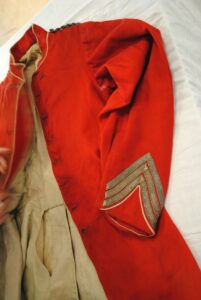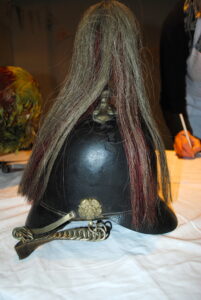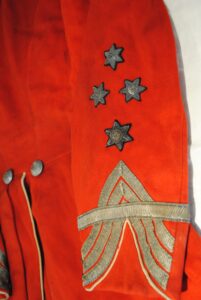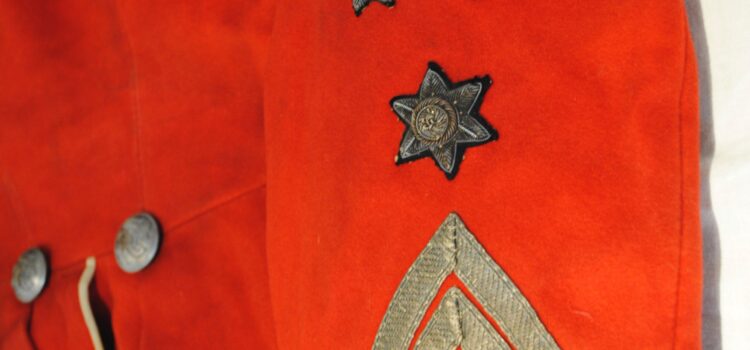This Jacket and Helmet help to shine a light on a fascinating part of Cambridge’s local military history.
The Museum’s costume and textile collection is very eclectic, for items vary from theatrical costumes to military and Red Cross uniforms and wedding dresses to University blazers and regalia. One red military jacket and helmet, however, have particular local significance.
At first sight, the jacket is a fairly ordinary pillar box red wool, lined, man’s military uniform coat, very typical of Army uniforms pre-WWI. The three silver metallic braid stripes suggest that the owner was an Army Sergeant. However, the line through the stripes on the right- hand sleeve and 4 stars above, together with the intertwined M.V.I. on the buttons, suggest otherwise. The first clues are given by the inner handwritten labels which say S H Rowley, Histon. Additionally, the helmet label says ‘D Troop’, which suggests a mounted regiment.
Who was this man? Research shows that Smith Howlett Rowley (1841 – 1930) was a farmer, and one of the principal landowners in Histon. He was also a magistrate, parish warden, poor law guardian and councillor. He was born in Trumpington but lived at Abbey Farm, Histon, for much of his adult life. The 1881 census records him as a farmer of 400 acres employing 15 men and 10 boys; following censuses list him merely as ‘farmer’. He married Grace Emmeline Balls in 1864 and they had 6 children, 3 boys and 3 girls.

How did he come to have the jacket? The Museum documentation suggests that the jacket belonged to the Cambridge Volunteer Brigade, but this has proven to be only part of the story. Sheer luck provided the correct answer: an internet search located a picture of a uniform owned by a W. T. Rowley, in the National Army Museum Collection.
Their label stated that the uniform of the other rank was worn by Private William Taylor Rowley, ‘D’ (Cambridge) Troop, 1st Huntingdonshire Light Horse Volunteers, circa. 1870. Family history confirmed that W. T. Rowley was the elder brother of S. H. Rowley and that the two brothers joined the Duke of Manchester’s Light horse volunteers around the time of its formation in 1860. The Duke of Manchester, based at Kimbolton Castle, had aped his friend the Earl of Sandwich in forming a local mounted volunteer force. However, the Manchesters favoured the traditional red tunics rather than the dark green of the Earl’s 1st Huntingdonshire Rifles. The Manchesters escorted HRH Princess Alexandra at her wedding in 1863 to HRH The Prince of Wales. Two years later the Prince became the regiment’s Colonel.

Members of the Manchesters were drawn from local county and farming elite. They had to be excellent horsemen and rich enough to pay both an annual subscription for the regimental privileges and for their own horses and uniforms. By all accounts they were dashing cavalry men of the first order.
The Rowley family feature strongly in the local press. The Cambridge Independent Press of June the 16th 1860 stated the following:
‘Cambs Mounted Volunteers, 40 gentlemen of the region, got together by HW Pemberton of Ansty Hall, Trumpington, who, by ‘hard training’, have ‘attained a degree of perfection in their exercises at various villages, with 2 afternoons a week set apart for the purpose. From Harston, Thomas S Hayes; Robert Long; WT Rowley; SH Rowley’.
In July 1883, newspaper reports showed that S H Rowley competed for the regimental Sword of Honour. He subsequently joined the 3rd Cambs Volunteer Battalion of the Suffolk Regiment when regimental reforms disbanded the Manchesters in the 1880s.

The jacket insignia give further leads as to S. H. Rowley’s role. The sleeve insignia suggest that he was either a staff sergeant or the regimental quartermaster, and that he saw active service. In 1899 a request went out for volunteers to join with the Regular Army units in the second Boer War campaign, and over 40 men from the 3rd Cambs Volunteer Brigade answered the call and went out to South Africa as part of the Volunteer Service Company of the Suffolk Regiment. Thus volunteers saw service with the regulars and further cemented the bonds between the “part timers” of Cambridgeshire and the regular soldiers of the Suffolk Regiment. Military records give a “Rowley H S” and a “Rowley S” who served in South Africa between 1899-1902 which suggests that the stars on the jacket record the battles and campaigns in which Rowley served.
Afterword: in September 2019 a collection of Regimental militaria relating to a Sergeant Smith H. Rowley was sold at Cheffins auction house. They included four silver cups, a silver equestrian statuette and a mahogany boxed presentation inscription sword; their citations proved S.H.Rowley’s proficiency with a sword. A regimental cap; red tunic and Cambridgeshire Yeomanry plumed helmet were also included but the auction catalogue does not provide any labels to confirm provenance.
A newspaper obituary of 1930 describes S.H. Rowley as the last of the ‘D Troop’ (Cambs) Duke of Manchester’s Light Horse Volunteers. We are glad that authenticated mementos of this obviously important man have found their way into the Museum.
This post was written by Carolyn Ferguson, a volunteer at the Museum of Cambridge.
